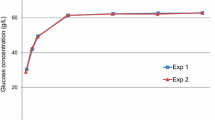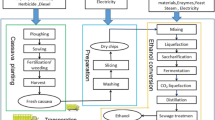Abstract
More than half of the bioethanol plants in operation today use corn or grains as raw materials. The downstream processing of mash after fermentation to produce ethanol and distiller grains is an energy-demanding process, which needs retrofitting for optimization. In addition, the fluctuation in the ethanol and grain prices affects the overall profitability of the plant. For this purpose, a process simulation was performed in Aspen Plus® based on an existing industrial plant located in Sweden. The simulations were compared using different scenarios including different concentrations of ethanol, using the stillage for biogas production to produce steam instead of distiller grains as a by-product, and altering the purity of the ethanol produced. Using stillage for biogas production, as well as utilizing the steam, reduced the overall energy consumption by 40 % compared to the plant in operation. The fluctuations in grain prices had a high impact on the net present value (NPV), where grain prices greater than 349 USD/ton reached a zero NPV. After 20 years, the plant in operation producing 41,600 tons ethanol/year can generate a profit of 78 million USD. Compared to the base case, the less purified ethanol resulted in a lower NPV of 30 million USD.





Similar content being viewed by others
Abbreviations
- DDGS:
-
Dried distillers grains with soluble
- TS:
-
Total solids
- NPV:
-
Net present value
- PBP:
-
Payback period
- CCP:
-
Cumulative cash position
- NFDS:
-
Non -fermentable dissolved solids
References
Bothast RJ, Schlicher MA (2005) Biotechnological processes for conversion of corn into ethanol. Appl Microbiol Biotechnol 67(1):19–25
Global Agricultural Information Network (2012) Biofuels annual report 2012. USDA Foreign Agricultural Service, Sao Paulo
Renewable Fuels Association (2014). http://www.ethanolrfa.org/. Accessed 07 May 2014
Pieragostini C, Aguirre P, Mussati MC (2014) Life cycle assessment of corn-based ethanol production in Argentina. Sci Total Environ 472:212–225
Food and Agricultural Organization (2012) FAOSTAT
International energy statistics (2011) Fuel ethanol statistics. In: US Energy information administration
Perkis D, Tyner W, Dale R (2008) Economic analysis of a modified dry grind ethanol process with recycle of pretreated and enzymatically hydrolyzed distillers’ grains. Bioresour Technol 99(12):5243–5249
Kim Y, Mosier N, Ladisch MR (2008) Process simulation of modified dry grind ethanol plant with recycle of pretreated and enzymatically hydrolyzed distillers’ grains. Bioresour Technol 99(12):5177–5192
Kwiatkowski JR, McAloon AJ, Taylor F, Johnston DB (2006) Modeling the process and costs of fuel ethanol production by the corn dry-grind process. Ind Crops Prod 23(3):288–296
Arifeen N, Wang R, Kookos IK, Webb C, Koutinas AA (2007) Process design and optimization of novel wheat-based continuous bioethanol production system. Biotechnol Prog 23(6):1394–1403
Quintero JA, Montoya MI, Sánchez OJ, Giraldo OH, Cardona CA (2008) Fuel ethanol production from sugarcane and corn: comparative analysis for a Colombian case. Energy 33(3):385–399
Elander RT, Putsche VL (1996) Ethanol from corn: technology and economics. In: Handbook on bioethanol: production and utilization. pp 329–349
Sokhansanj S, Mani S, Tagore S, Turhollow AF (2010) Techno-economic analysis of using corn stover to supply heat and power to a corn ethanol plant-part 1: cost of feedstock supply logistics. Biomass Bioenergy 34(1):75–81
Liu K, Barrows FT (2013) Methods to recover value-added coproducts from dry grind processing of grains into fuel ethanol. J Agric Food Chem 61(30):7325–7332
Rajendran K, Kankanala HR, Lundin M, Taherzadeh MJ (2014) A novel process simulation model (PSM) for anaerobic digestion using Aspen Plus. Bioresour Technol 168:7–13
Rajendran K, Kankanala HR, Martinsson R, Taherzadeh MJ (2014) Uncertainty over techno-economic potentials of biogas from municipal solid waste (MSW): a case study on an industrial process. Appl Energy 125:84–92. doi:10.1016/j.apenergy.2014.03.041
Turton R, Bailie RC, Whiting WB, Shaeiwitz JA, Bhattacharyya D (2012) Analysis, synthesis and design of chemical processes. Pearson Education, Upper Saddle River
Wooley R, Ruth M, Glassner D, Sheehan J (1999) Process design and costing of bioethanol technology: a tool for determining the status and direction of research and development. Biotechnol Prog 15(5):794–803
Wooley R, Ruth M, Sheehan J, Ibsen K, Majdeski H, Galvez A (1999) Lignocellulosic biomass to ethanol process design and economics utilizing co-current dilute acid prehydrolysis and enzymatic hydrolysis current and futuristic scenarios. In: DTIC document
Lang X, Macdonald DG, Hill GA (2001) Recycle bioreactor for bioethanol production from wheat starch II. Fermentation and economics. Energy Sources 23(5):427–436
Barta Z, Reczey K, Zacchi G (2010) Techno-economic evaluation of stillage treatment with anaerobic digestion in a softwood-to-ethanol process. Biotechnol Biofuels 3(1):1–11
Acknowledgments
The authors would like to thank the Swedish Energy Agency for their financial support and Lantmännen Agroetanol AB, Sweden for sharing the data of the plant. We also acknowledge Thomas Södergren for his computer support.
Author information
Authors and Affiliations
Corresponding author
Rights and permissions
About this article
Cite this article
Rajendran, K., Rajoli, S., Teichert, O. et al. Impacts of retrofitting analysis on first generation ethanol production: process design and techno-economics. Bioprocess Biosyst Eng 38, 389–397 (2015). https://doi.org/10.1007/s00449-014-1278-2
Received:
Accepted:
Published:
Issue Date:
DOI: https://doi.org/10.1007/s00449-014-1278-2




